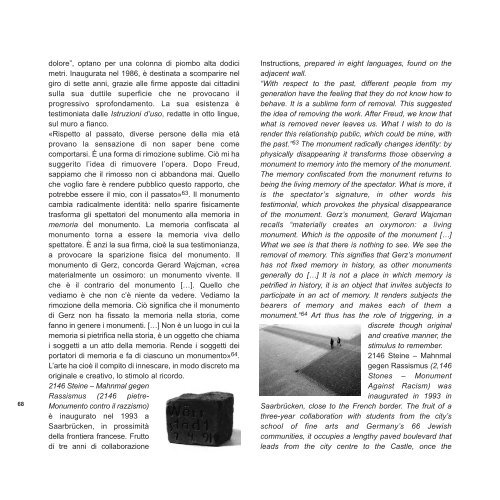Adachiara Zevi - arteinmemoria
Adachiara Zevi - arteinmemoria
Adachiara Zevi - arteinmemoria
Create successful ePaper yourself
Turn your PDF publications into a flip-book with our unique Google optimized e-Paper software.
68<br />
dolore”, optano per una colonna di piombo alta dodici<br />
metri. Inaugurata nel 1986, è destinata a scomparire nel<br />
giro di sette anni, grazie alle firme apposte dai cittadini<br />
sulla sua duttile superficie che ne provocano il<br />
progressivo sprofondamento. La sua esistenza è<br />
testimoniata dalle Istruzioni d’uso, redatte in otto lingue,<br />
sul muro a fianco.<br />
«Rispetto al passato, diverse persone della mia età<br />
provano la sensazione di non saper bene come<br />
comportarsi. È una forma di rimozione sublime. Ciò mi ha<br />
suggerito l’idea di rimuovere l’opera. Dopo Freud,<br />
sappiamo che il rimosso non ci abbandona mai. Quello<br />
che voglio fare è rendere pubblico questo rapporto, che<br />
potrebbe essere il mio, con il passato» 63 . Il monumento<br />
cambia radicalmente identità: nello sparire fisicamente<br />
trasforma gli spettatori del monumento alla memoria in<br />
memoria del monumento. La memoria confiscata al<br />
monumento torna a essere la memoria viva dello<br />
spettatore. È anzi la sua firma, cioè la sua testimonianza,<br />
a provocare la sparizione fisica del monumento. Il<br />
monumento di Gerz, concorda Gerard Wajcman, «crea<br />
materialmente un ossimoro: un monumento vivente. Il<br />
che è il contrario del monumento […]. Quello che<br />
vediamo è che non c’è niente da vedere. Vediamo la<br />
rimozione della memoria. Ciò significa che il monumento<br />
di Gerz non ha fissato la memoria nella storia, come<br />
fanno in genere i monumenti. […] Non è un luogo in cui la<br />
memoria si pietrifica nella storia, è un oggetto che chiama<br />
i soggetti a un atto della memoria. Rende i soggetti dei<br />
portatori di memoria e fa di ciascuno un monumento» 64 .<br />
L’arte ha cioè il compito di innescare, in modo discreto ma<br />
originale e creativo, lo stimolo al ricordo.<br />
2146 Steine – Mahnmal gegen<br />
Rassismus (2146 pietre-<br />
Monumento contro il razzismo)<br />
è inaugurato nel 1993 a<br />
Saarbrücken, in prossimità<br />
della frontiera francese. Frutto<br />
di tre anni di collaborazione<br />
Instructions, prepared in eight languages, found on the<br />
adjacent wall.<br />
“With respect to the past, different people from my<br />
generation have the feeling that they do not know how to<br />
behave. It is a sublime form of removal. This suggested<br />
the idea of removing the work. After Freud, we know that<br />
what is removed never leaves us. What I wish to do is<br />
render this relationship public, which could be mine, with<br />
the past.” 63 The monument radically changes identity: by<br />
physically disappearing it transforms those observing a<br />
monument to memory into the memory of the monument.<br />
The memory confiscated from the monument returns to<br />
being the living memory of the spectator. What is more, it<br />
is the spectator’s signature, in other words his<br />
testimonial, which provokes the physical disappearance<br />
of the monument. Gerz’s monument, Gerard Wajcman<br />
recalls “materially creates an oxymoron: a living<br />
monument. Which is the opposite of the monument […]<br />
What we see is that there is nothing to see. We see the<br />
removal of memory. This signifies that Gerz’s monument<br />
has not fixed memory in history, as other monuments<br />
generally do […] It is not a place in which memory is<br />
petrified in history, it is an object that invites subjects to<br />
participate in an act of memory. It renders subjects the<br />
bearers of memory and makes each of them a<br />
monument.” 64 Art thus has the role of triggering, in a<br />
discrete though original<br />
and creative manner, the<br />
stimulus to remember.<br />
2146 Steine – Mahnmal<br />
gegen Rassismus (2,146<br />
Stones – Monument<br />
Against Racism) was<br />
inaugurated in 1993 in<br />
Saarbrücken, close to the French border. The fruit of a<br />
three-year collaboration with students from the city’s<br />
school of fine arts and Germany’s 66 Jewish<br />
communities, it occupies a lengthy paved boulevard that<br />
leads from the city centre to the Castle, once the


